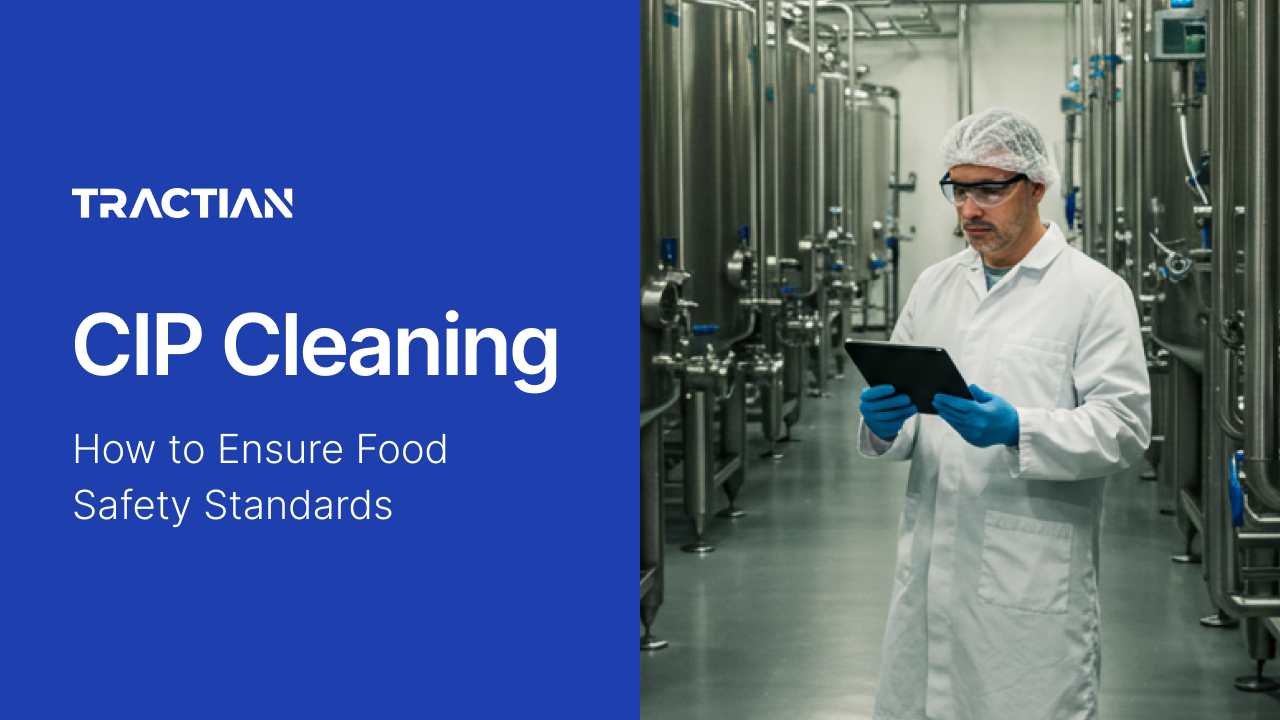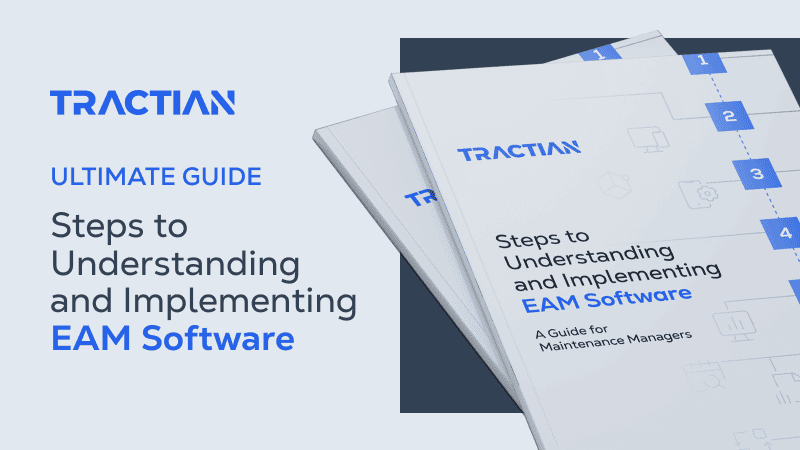In food and beverage manufacturing, sanitation is the expectation at every stage of production. Equipment must be cleaned consistently, documented properly, and verified against strict compliance standards to avoid risks that could halt operations or trigger recalls.
Clean-in-Place (CIP) systems were developed to meet these demands. Instead of relying on disassembly and manual scrubbing, CIP systems deliver controlled cleaning cycles automatically inside tanks, pipelines, and processing equipment.
Every parameter, from temperature to chemical concentration, is monitored to ensure repeatable, validated results.
But CIP isn’t just about having the right equipment, it’s about transforming cleaning into a process that supports safety, compliance, and operational excellence. So, how does CIP work, and how can CMMS help teams streamline cleaning cycles?
What is Clean-in-Place (CIP) Cleaning?
Clean-in-Place (CIP) was engineered to solve a major industrial problem: reducing downtime caused by manual cleaning while guaranteeing that every cleaning cycle meets strict sanitation standards.
It’s a methodical cleaning process that removes soil, debris, and microbial contaminants from the internal surfaces of process equipment without disassembly.
Components are cleaned automatically by circulating a series of chemical solutions, rinse water, and sanitizers under controlled flow, temperature, and concentration parameters.
By automating the cleaning process, facilities not only minimize human error but also achieve repeatable, auditable cleaning results that meet strict regulations.
In a standard CIP system, a cleaning cycle includes several stages:
- A pre-rinse to remove loose soil.
- A detergent wash to dissolve fats, proteins, and residues.
- An intermediate rinse to flush chemical residues.
- A sanitization phase using either chemical disinfectants or thermal methods.
- A final rinse (if required) to prepare equipment for production.
This cycle is designed to eliminate manual intervention entirely, improving the safety and consistency of the cleaning process.
How Does CIP Cleaning Work?
CIP cleaning operates on a closed-loop system. When equipment is dirty, cleaning solution is driven through its interior surfaces, triggering the process.
Each cleaning cycle relies on four key variables, known as T.A.C.T. (Time, Action, Chemical, Temperature), to ensure effective soil removal and microbial control.
1. Time
How long each cleaning solution remains in contact with equipment surfaces is critical. Shorter times may not fully dissolve residues, while excessive exposure can lead to equipment damage or wasted resources. CIP systems define specific contact times for each cleaning phase based on the system's design.
2. Action
This is the mechanical force applied by fluid movement. Action can involve turbulent flow inside pipelines or spray coverage within tanks. Ultimately, the right velocity must be achieved to create shear forces strong enough to detach soil from surfaces without causing erosion or mechanical stress.
3. Chemical
The selection and concentration of cleaning chemicals must match the type of internal debris. For example, protein residues require a different composition and concentration than mineral scales. This is why CIP systems automatically dose and monitor chemical concentrations throughout each cycle.
4. Temperature
Higher temperatures generally accelerate chemical reactions and improve soil removal. However, temperatures that are too high can cause thermal damage to equipment surfaces or denature certain soils, which makes cleaning more difficult.
Modern CIP systems avoid this by monitoring critical cleaning parameters through sensors and automated controllers. For example, temperature probes ensure thermal thresholds are achieved.
The Role of CIP in Food Safety
The importance of CIP systems can’t be overstated.
Without consistent and validated cleaning cycles, microbial hazards like Listeria monocytogenes and E. coli can develop along improperly cleaned surfaces. Even minor deviations like incomplete rinsing can allow biofilms to form, compromising both product integrity and consumer safety.
Regulatory frameworks and global standards like SQF and BRCGS explicitly require documented, validated cleaning processes for food-contact equipment.
CIP systems directly address these requirements by enabling standardized, automated cleaning with full traceability of critical parameters.
In validated CIP operations, plants not only demonstrate that their cleaning cycles meet microbial and chemical residue standards, they also ensure interventions are reproducible and verifiable across different production shifts and product lines.
CIP vs. COP Cleaning: Key Differences
While Clean-in-Place (CIP) and Clean-out-of-Place (COP) systems can both achieve sanitary conditions in food processing equipment, they differ fundamentally in method, operational impact, and application.
CIP cleaning is performed without disassembling equipment. Cleaning solutions are circulated through closed systems, and every critical cleaning parameter is automatically controlled and recorded.
This approach minimizes downtime and ensures cleaning validation without interrupting production flow.
COP cleaning, on the other hand, requires equipment to be partially or fully disassembled. Components are then immersed in wash tanks with cleaning and sanitizing solutions.
This method is used when internal components are too complex for effective CIP coverage or when equipment design lacks integrated cleanability features.
Here are a few key operational differences between CIP and COP cleaning:

Choosing between CIP and COP isn’t an either-or decision. Many food and beverage facilities use both methods.
However, designing processes for CIP compatibility whenever possible yields major long-term advantages, especially when paired with maintenance management systems that enforce cleaning schedules and document compliance automatically.
Advantages of Installing a CIP System
Implementing a Clean-in-Place (CIP) system offers significant operational, safety, and financial advantages, including:
1. Reduced Downtime
Since CIP systems eliminate the need for equipment disassembly, production interruptions are minimized. Instead, cleaning cycles run automatically with controlled parameters, creating faster turnaround times between product runs or shift changes.
This level of efficiency directly impacts throughput and overall equipment effectiveness (OEE).
2. Consistency and Repeatability
Manual cleaning introduces variability from cycle to cycle. CIP installations make sure every cleaning run follows the same validated protocol, every time.
This consistency is critical for regulatory compliance, especially in HACCP-validated facilities.
3. Labor Optimization
Automating the cleaning process reduces the need for manual labor during sanitation cycles. This means operators can focus on production tasks or quality assurance checks rather than scrubbing equipment.

4. Resource Efficiency
Well-designed CIP systems optimize water usage, chemical consumption, and energy requirements.
For example, advanced CIP skids feature recovery loops for rinse water reuse, precise chemical dosing, and automated temperature control, reducing both your plant’s environmental footprint and operating costs.
5. Enhanced Safety
Manually cleaning confined spaces like tanks or pipe interiors introduces significant safety risks, from chemical exposure to fall hazards. CIP systems isolate these cleaning processes, limiting human interaction with hazardous substances.
6. Full Cleaning Traceability
Integrated sensors and controllers log critical cleaning data in real time, creating auditable cleaning records that support internal quality programs and external inspections.
Challenges of Installing a CIP System
While Clean-in-Place (CIP) systems deliver major operational advantages, they also come with specific challenges that maintenance teams, engineers, and plant managers must address to ensure long-term efficiency and compliance.
1. High Initial Investment
CIP systems are expensive to design and install. And customizing CIP loops for complex production lines, especially retrofits in older plants, can further increase costs.
Your ROI calculations should not only account for these upfront expenses but also operational savings over the system's lifecycle.
2. System Complexity
Automated CIP installations involve multiple subsystems, including:
- Chemical dosing skids
- Recirculation pumps
- Heat exchangers
- Conductivity meters
- Temperature probes
- Programmable logic controllers (PLCs)
Maintaining, calibrating, and troubleshooting these components demands a higher level of technical skill that teams might not have.
3. Risk of Cleaning Validation Failure
Poorly designed CIP systems with insufficient turbulence or improper chemical dosing can result in ineffective cleaning.
What’s more, a failed cleaning validation not only risks product contamination but also exposes your facility to non-compliance penalties and operational shutdowns.
4. Potential for Resource Waste
Without properly optimized cycles, CIP systems don’t save resources, they use too much. Facilities that fail to monitor and adjust their CIP parameters regularly may erode the very cost efficiencies that justify CIP installation in the first place.
5. Limited Flexibility for Complex Equipment
Some assets, especially small, intricate, or non-standardized machinery, are not easily integrated into a CIP loop. In cases like these, a hybrid approach combining CIP and COP cleaning strategies may still be necessary.
CIP Applications in Food and Beverage
Clean-in-Place (CIP) systems are essential across multiple segments of the food and beverage industry.
Their application ensures consistent cleaning of internal surfaces in process equipment without requiring dismantling, supporting both product integrity and regulatory compliance.
Below are some of the most common areas that CIP is applied:
Dairy Processing
CIP is mandatory in dairy plants where production requires high levels of microbial control. Pasteurizers, homogenizers, filling machines, and piping networks all rely on CIP to prevent bacterial growth and ensure cross-contamination risks are mitigated between product runs.
Beverage Production
In breweries, soft drink plants, and juice processing facilities, CIP systems clean fermenters, bright beer tanks, syrup lines, and carbonation systems. These systems also minimize downtime between product changeovers and ensure consistent taste profiles by eliminating flavor carryover.
Meat and Poultry Processing
CIP systems are used in chilling lines, brine injectors, and liquid handling equipment to reduce microbial load and meet USDA and FDA sanitation standards.
Bakery and Confectionery
Chocolate production lines, icing systems, and high-sugar processing equipment often integrate CIP to remove residues that can harbor microbial growth or affect product quality. CIP also reduces allergens' cross-contact risks in multi-product facilities.
Infant Formula and Nutraceuticals
For high-risk, high-purity products like infant formula or vitamin preparations, CIP ensures strict hygiene to meet pharmaceutical-grade cleanliness.
Key Considerations in CIP Cleaning
Successful CIP implementation goes beyond installing pumps and spray devices, it requires engineering every cleaning cycle with predictability in mind.
System Design for Cleanability
Equipment must be designed or modified to support complete internal cleaning without disassembly.
This includes minimizing dead legs, ensuring smooth interior finishes (typically 32 Ra microinches or better), maintaining cleanable welds, and eliminating crevices that can harbor contaminants. Piping layouts should also support full drainage and turbulent flow at cleaning velocities.
Control of Critical Cleaning Parameters
Cleaning parameters must be consistently monitored and controlled throughout each CIP cycle. Failing to maintain turbulence or incorrect chemical dosing, for example, can lead to incomplete soil removal or residual contamination.
Selection of Cleaning Agents
Choosing the right detergent and sanitizer depends on the type of fouling and the material compatibility of the equipment.
Caustic cleaners, acid descalers, and oxidizing sanitizers should each be specified to match product residues and operational safety requirements.
Validation and Verification
CIP cycles need to be validated to ensure they meet microbial and residue removal specifications under worst-case soil loading conditions.
Once validated, verification procedures like conductivity checks must be routinely applied to ensure the cleaning process remains effective over time.
System Automation and Monitoring
Automated control systems enhance repeatability and enable real-time monitoring of cleaning parameters. This level of automation reduces human error, provides electronic batch records for compliance, and enables maintenance and QA teams to stay proactive.
Why Consistent CIP Cleaning Matters for Compliance
Consistency with CIP isn’t just best practice, it’s a direct regulatory requirement tied to product safety, legal liability, and brand protection.
Frameworks such as the Food Safety Modernization Act and the USDA’s Meat and Poultry regulations all require validated cleaning processes with verifiable documentation.
Put simply, the burden of proof lies on your facility to demonstrate that equipment cleaning is performed consistently, effectively, and according to an established, validated plan.
Any deviations from validated cycles must be documented through corrective actions and risk assessments. Any failure to do so is a direct breach of your facility’s food safety plan and can trigger production holds (or, in the most severe cases, total shutdown).
Key Performance Indicators (KPIs) to Track for CIP Efficiency
Clean-in-Place cleaning should be treated like any other critical process: it should be measured, analyzed, and improved based on real data.
Here are the key indicators your technical teams should keep an eye on:
Cycle Time Efficiency
CIP cycles should complete within a validated time frame. If cleaning takes longer than expected, it may indicate an underperforming pump, a blocked line, or other issues that compromise cleaning.
Chemical Consumption per Cycle
Facilities must control the volume of detergents and sanitizers used during CIP. The wrong balance leads to cleaning failures, non-compliance risks, and inflated chemical costs.
Water and Energy Usage
Efficient CIP systems minimize water and heating requirements without compromising sanitation. Tracking water volume and energy input during each cycle identifies inefficiencies, while excessive consumption flags system problems like valve leaks or incorrect sequencing.
Validation Pass Rate
A high validation rate means cleaning cycles consistently meet all predefined parameters. Any drop in this rate signals issues that need immediate corrective action.
Cleaning-Related Downtime
Monitoring the hours lost due to cleaning-related delays, whether from cycle failures, re-cleans, or verification issues, showcases the direct impact of CIP’s impact on production availability and OEE (Overall Equipment Effectiveness).
Resource Recovery Efficiency
In systems equipped for solution recovery, teams should track the percentage of cleaning solutions and rinse water successfully captured and reused. Poor recovery rates point to process faults that will drive up operational costs over time.
Integrating CIP Validation into Your Maintenance Strategy
Validating your Clean-in-Place (CIP) systems should be embedded into your facility’s maintenance strategy to ensure cleaning processes remain effective, repeatable, and compliant over the long term.
Without this, you open the doors to avoidable microbial risks, product recalls, and regulatory penalties.
But integrating CIP validation into your maintenance operations doesn’t have to be difficult. Here’s where to start:
1. Establish Validation Protocols as Maintenance Tasks
Temperature profiling, chemical concentration checks, and flow rate verification should be scheduled and tracked through the same CMMS platform used for preventive maintenance.
Each validation step must have a clear task description, defined frequencies, acceptance criteria, and responsible personnel assigned.
2. Monitor Critical Cleaning Parameters Continuously
Real-time monitoring sensors should be maintained as critical assets within the maintenance plan. Regularly calibrating these instruments must be enforced to guarantee the accuracy of cleaning cycle records used for validation.
3. Tie CIP Validation to Asset Health Monitoring
CIP system performance degradation is often an early indicator of broader mechanical issues.
Linking CIP cycle deviations (for example, failure to reach flow velocity or incomplete rinsing) to asset condition monitoring programs helps maintenance teams intervene early.
4. Create Electronic Cleaning Validation Records
Manual documentation processes introduce errors and gaps that can fail audits. Validation results, like chemical concentration logs or microbial swab results, should be captured digitally inside the CMMS or QA system.
This creates time-stamped, version-controlled records that are available for internal reviews and third-party inspections.
5. Align Cleaning Validation with Regulatory and Customer Standards
Validation tasks need to reflect the regulatory requirements relevant to your facility. Maintenance strategies should adapt CIP validation tasks whenever regulations or customer expectations evolve.
How Tractian’s CMMS Helps with CIP and Food Safety
Managing CIP cleaning manually or across scattered systems leaves too much to chance–and in food safety, there’s no room for unnecessary risks.
Tractian’s CMMS connects your maintenance operations and sanitation routines into a single, controlled environment. CIP cleaning schedules are integrated directly into preventive maintenance plans, ensuring every cleaning cycle is triggered on time, executed according to validated parameters, and fully documented for traceability.
We also support continuous improvement by giving your team visibility into resource usage (water, chemicals, energy) and downtime tied to sanitation events. Over time, this data-driven approach helps plants optimize CIP efficiency, reduce operational costs, and maintain a proactive food safety posture.
Facilities that integrate Tractian’s CMMS into their cleaning and maintenance strategy don’t just react to problems, they build a verified, sustainable sanitation program that stands up to regulatory inspections and protects long-term operational reliability.



